Listcrollers are user interface components commonly found in software applications and websites. They serve the purpose of displaying lists of items in a scrollable format, allowing users to navigate through content efficiently. Listcrollers are essential elements in various contexts, ranging from simple to complex interfaces. Whether you’re browsing through a list of products on an e-commerce website, scrolling through your social media feed, or managing tasks in a to-do list app, chances are you’re interacting with a listcroller.
Types of Listcrollers and Their Functions
Listcrollers come in various types, each serving specific functions tailored to different user interface needs. Here are some common types of list crollers along with their functions:
- Vertical Listcrollers:
- Function: Vertical list crollers display items in a single column, allowing users to scroll up and down to navigate through content.
- Use Cases: Ideal for presenting lists of items such as articles, products, or contacts where the content exceeds the available vertical space on the screen.
- Horizontal Listcrollers:
- Function: Horizontal listcrollers present items in a row, enabling users to scroll sideways to view more content.
- Use Cases: Suitable for displaying horizontally oriented content like images, thumbnails, or navigation menus, especially on devices with limited vertical space.
- Hybrid Listcrollers:
- Function: Hybrid list crollers combine both vertical and horizontal scrolling directions, offering flexibility in content presentation.
- Use Cases: Useful for showcasing content that benefits from both vertical and horizontal navigation, such as image galleries or timelines.
- Carousel Listcrollers:
- Function: Carousel listcrollers display a set of items in a slideshow format, automatically transitioning between them or allowing manual navigation.
- Use Cases: Commonly used for showcasing visual content like images, videos, or advertisements in an engaging and interactive manner.
- Infinite Listcrollers:
- Function: Infinite list crollers dynamically load additional content as the user scrolls, providing an endless browsing experience.
- Use Cases: Particularly useful for applications or websites with large datasets or continuous streams of content, ensuring smooth and uninterrupted browsing.
- Grid Listcrollers:
- Function: Grid listcrollers arrange items in a grid layout, enabling users to scroll through rows and columns of content.
- Use Cases: Suitable for displaying structured content such as thumbnails, product grids, or photo galleries in a compact and organized manner.
Key Features and Benefits of Listcrollers
Listcrollers offer several key features and benefits that contribute to improved user experience and interface usability. Here are some of the primary advantages:
- Efficient Content Organization: Listcrollers facilitate the organization of large amounts of content within limited screen space, enabling users to navigate through extensive lists or datasets seamlessly.
- Seamless Navigation: By providing smooth scrolling functionality, listcrollers allow users to browse through content effortlessly, enhancing the overall navigation experience.
- Customizable Interaction: Many list crollers support interactive features such as filtering, sorting, and searching, empowering users to customize their viewing experience and find relevant content more efficiently.
- Space Optimization: Listcrollers help optimize screen real estate by displaying content in a compact and scrollable format, maximizing the amount of information that can be presented without cluttering the interface.
- Enhanced Visual Appeal: Incorporating animations, transitions, and responsive design principles, listcrollers can enhance the visual appeal of interfaces, making content more engaging and captivating for users.
- Accessibility: Listcrollers contribute to accessibility by providing intuitive navigation options that accommodate users with diverse needs and preferences, including those using assistive technologies or navigating with limited mobility.
- Improved Engagement: With features like carousel functionality or infinite scrolling, listcrollers can increase user engagement by presenting content in an interactive and dynamic manner, encouraging exploration and interaction.
- Streamlined Content Consumption: Listcrollers facilitate efficient content consumption by presenting information in a structured and easily scannable format, reducing cognitive load and helping users quickly find what they’re looking for.
How Listcrollers Enhance User Experience
Listcrollers significantly enhance user experience in various ways:
- Efficient Navigation: Listcrollers allow users to quickly and easily navigate through large sets of content, improving efficiency and reducing frustration.
- Content Organization: By organizing information into scrollable lists, listcrollers help users find what they need more effectively, enhancing the overall usability of interfaces.
- Customization Options: Many list crollers offer features such as filtering, sorting, and search functionalities, enabling users to personalize their browsing experience and find relevant content faster.
- Space Optimization: Listcrollers maximize screen space by displaying content in a compact format, ensuring that users can access a significant amount of information without cluttering the interface.
- Visual Engagement: Incorporating smooth animations and transitions, list crollers create a visually appealing browsing experience that keeps users engaged and encourages exploration.
- Accessibility: Listcrollers contribute to accessibility by providing intuitive navigation options that cater to users with diverse needs and preferences, ensuring an inclusive user experience for all.
Best Practices for Implementing Listcrollers
To maximize the effectiveness of listcrollers, consider the following best practices when implementing them:
- Prioritize User Needs: Understand your users’ goals and preferences to design list crollers that meet their specific needs and enhance their overall experience.
- Keep it Simple: Avoid overwhelming users with too many options or features. Keep the interface clean and intuitive, focusing on essential functionalities that add value to the user experience.
- Optimize Performance: Ensure that list crollers load quickly and scroll smoothly, even when dealing with large datasets. Optimize performance to provide a seamless browsing experience for users.
- Responsive Design: Design listcrollers that adapt to different screen sizes and devices, ensuring consistency and usability across various platforms and screen resolutions.
- Accessibility Considerations: Implement accessibility features such as keyboard navigation and screen reader compatibility to ensure that list crollers are usable by all users, including those with disabilities.
- Testing and Iteration: Test listcrollers with real users to identify any usability issues or areas for improvement. Use feedback to iterate and refine the design for optimal performance and user satisfaction.
Comparison of Popular Listcroller Tools
There are several popular listcroller tools available, each with its unique features and functionalities. Here’s a comparison of some of the most widely used list croller tools:
- jQuery UI Scrollable: Provides a simple and lightweight solution for creating scrollable lists with customizable options for scrollbars and scrolling behavior.
- React Virtualized: Ideal for handling large datasets efficiently, React Virtualized uses virtualization techniques to render only the visible portion of the list, improving performance and reducing memory usage.
- Infinite Scroll: A popular JavaScript library for implementing infinite scrolling listcrollers, Infinite Scroll dynamically loads additional content as users scroll down the page, offering a seamless browsing experience.
- Slick Carousel: Known for its versatility and ease of use, Slick Carousel offers a wide range of carousel features and customization options, making it suitable for creating interactive and visually appealing slideshows.
- Flutter ListView: Specifically designed for mobile app development, Flutter ListView provides a flexible and efficient way to create scrollable lists in Flutter applications, with built-in support for various scrolling effects and gestures.
Integrating Listcrollers into Web Design: Tips and Tricks
- Prioritize Mobile Responsiveness: Ensure that listcrollers are responsive and adapt well to different screen sizes, especially on mobile devices where space is limited.
- Optimize Loading Performance: Implement lazy loading techniques to efficiently load and render list items as needed, improving page loading times and overall performance.
- Consider User Interaction: Design intuitive user interfaces with clear navigation cues and feedback mechanisms to guide users effectively through the list content.
- Customize Appearance: Customize the styling and appearance of list crollers to match the overall design aesthetic of your website, creating a cohesive and visually appealing user experience.
- Test Across Browsers and Devices: Thoroughly test listcrollers across various web browsers and devices to ensure consistent functionality and usability across different platforms.
Accessibility Considerations for Listcrollers
- Keyboard Navigation: Ensure that listcrollers can be navigated using keyboard controls, allowing users who rely on keyboard input to access and interact with list content easily.
- Screen Reader Compatibility: Make list crollers compatible with screen readers by providing appropriate aria attributes and semantic markup, enabling users with visual impairments to access and understand the list content.
- Focus Management: Manage focus states and keyboard focus indicators effectively to maintain accessibility for users navigating through list crollers using keyboard navigation.
- Contrast and Color Accessibility: Ensure sufficient color contrast and avoid relying solely on color cues to convey information in list crollers, making content accessible to users with color vision deficiencies.
- Accessible Scrollbars: Use native browser scrollbars or implement accessible custom scrollbars that are compatible with assistive technologies and provide a familiar browsing experience for users.
Future Trends in Listcroller Technology
- Enhanced Interaction: Future listcroller technologies may incorporate advanced interaction techniques such as gesture-based scrolling, voice commands, or haptic feedback to further improve user engagement and interaction.
- AI-Powered Personalization: AI-driven algorithms may enable list crollers to personalize content recommendations based on user preferences, behavior patterns, and contextual factors, enhancing the relevance and usefulness of list content.
- Augmented Reality Integration: With the rise of augmented reality (AR) technologies, list crollers could integrate AR features to enable immersive and interactive browsing experiences, allowing users to interact with virtual content in real-world environments.
- Seamless Cross-Platform Integration: Future list croller technologies may focus on providing seamless integration across multiple platforms and devices, allowing users to access and synchronize list content seamlessly across different devices and environments.
Troubleshooting Common Issues with Listcrollers
- Performance Optimization: Address performance issues such as slow loading times or choppy scrolling by optimizing code, reducing unnecessary DOM manipulation, and implementing efficient rendering techniques.
- Compatibility Problems: Troubleshoot compatibility issues with different web browsers or devices by testing and debugging code, ensuring consistent behavior and functionality across various platforms.
- Responsive Design Challenges: Resolve responsive design challenges such as layout inconsistencies or overlapping elements by using CSS media queries and responsive design principles to adapt listcrollers to different screen sizes and resolutions.
- Accessibility Concerns: Address accessibility issues such as keyboard navigation problems or screen reader compatibility issues by reviewing and updating markup, adding appropriate aria attributes, and conducting accessibility testing with assistive technologies.
- User Experience Improvements: Identify and address usability issues or user experience problems such as confusing navigation or unclear feedback by gathering user feedback, conducting usability testing, and iteratively refining the design of list crollers for optimal usability and user satisfaction.
Conclusion
In conclusion, listcrollers play a pivotal role in enhancing user experience and improving interface usability across various digital platforms. By efficiently organizing and presenting content in a scrollable format, listcrollers enable seamless navigation, streamline content consumption, and optimize screen real estate. With features such as customization options, visual engagement, and accessibility considerations, listcrollers contribute to creating intuitive and engaging user interfaces that cater to the diverse needs and preferences of users.






